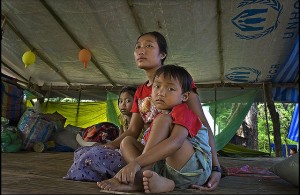
Some Burmese refugee children heading to the U.S. have toxic levels of lead in the blood, according to a study released this week in the journal Pediatrics. Researchers at the Center for Disease Control and Prevention measured lead levels in Burmese children living in Thai refugee camps. They found that children under age two were at highest risk. Fifteen percent of them had lead poisoning, as did five percent of all children. That compares to less than one percent of all children in the U.S. [PDF] But Burmese refugee children who resettle in Oakland may not be very safe against lead exposure, once they arrive here.
Joan Jeung, a pediatrician who works with Burmese refugees at Asian Health Services in Oakland, was quick to identify the problem. "Moving from a low-income area and conditions of political oppression in Burma, to low-income areas here in the United States where environmental lead levels area still high, I think the quickest link to find is poverty."
About 400 Burmese refugees resettled in Oakland since 2007, and the majority are living in extreme poverty, with many families surviving on less than $1,000 a month, according to a joint study by San Francisco State University and the Burma Refugee Family Network. In addition nearly two-thirds of them are unemployed.
Many Burmese refugees in Oakland live in older, low-income homes that may have lead-based materials in the house -- like the paint on the walls. Jeung says those with younger kids should be particularly cautious in such living situations.